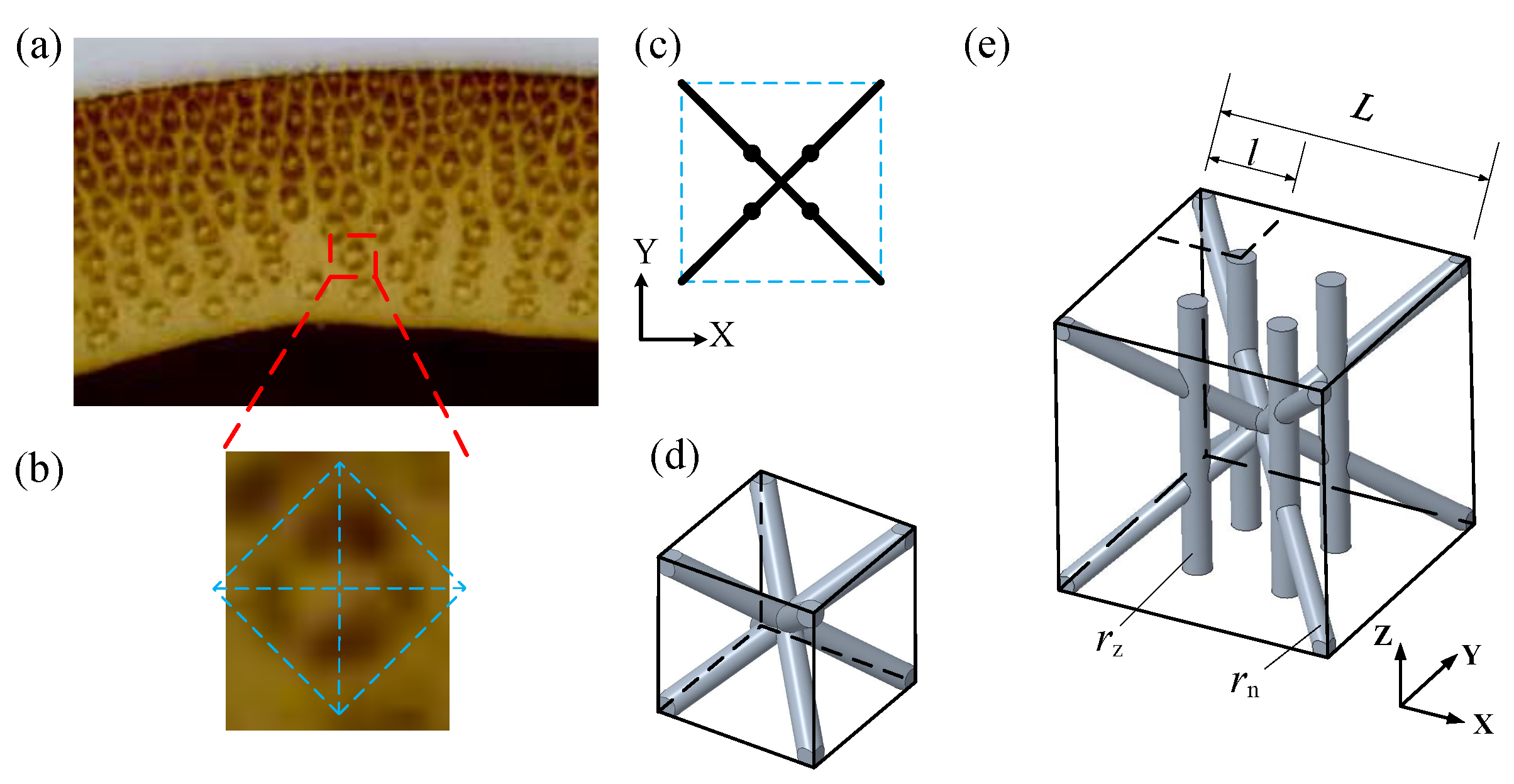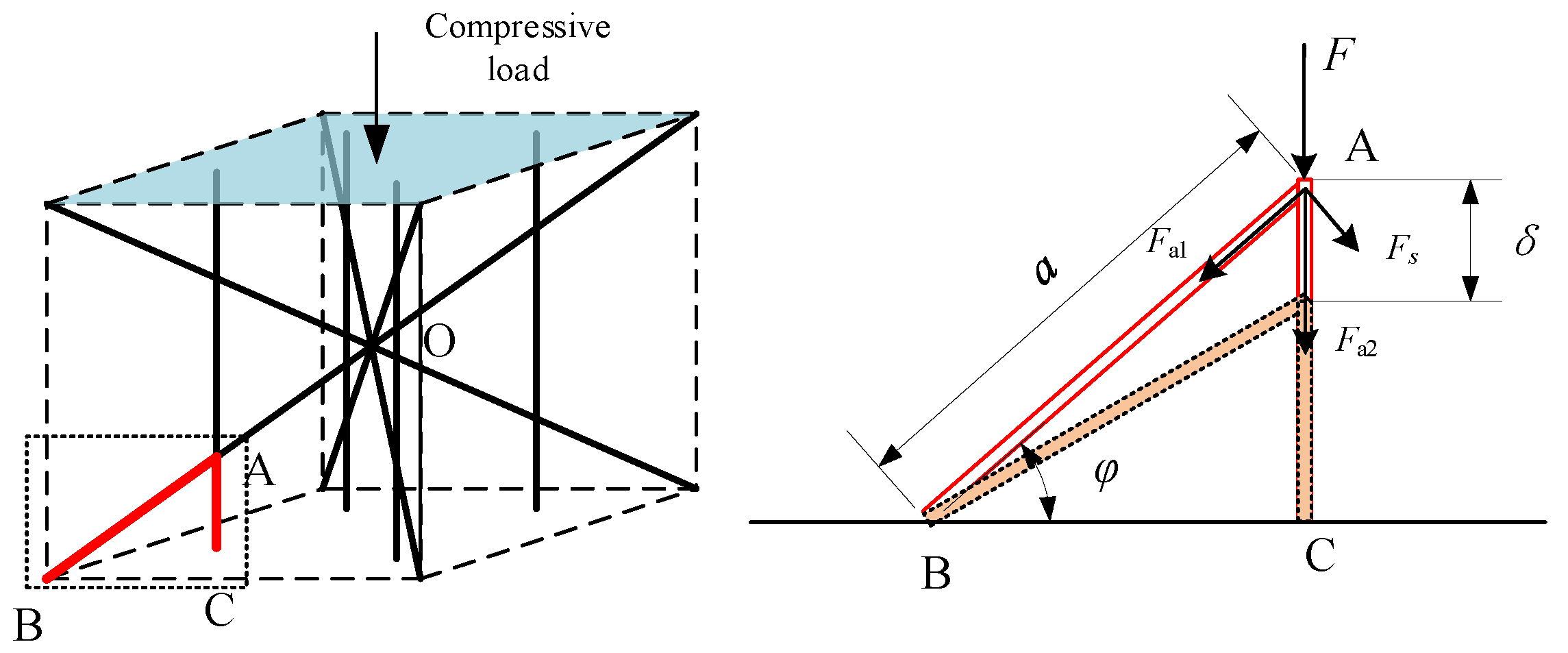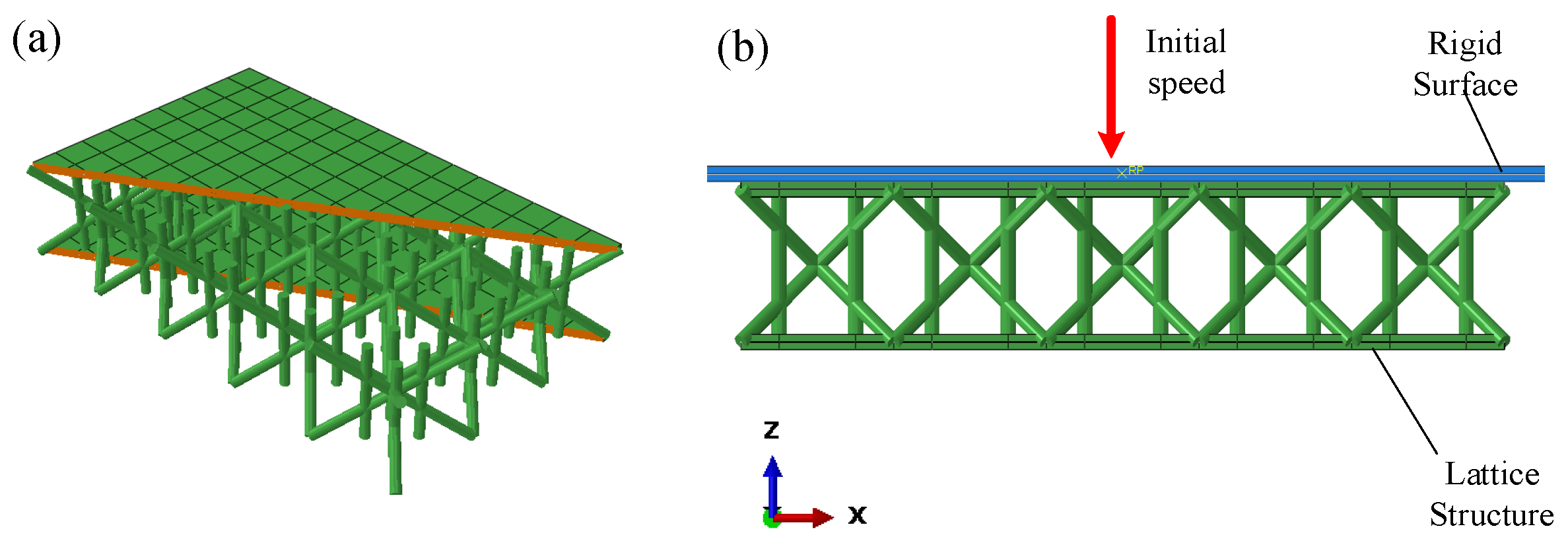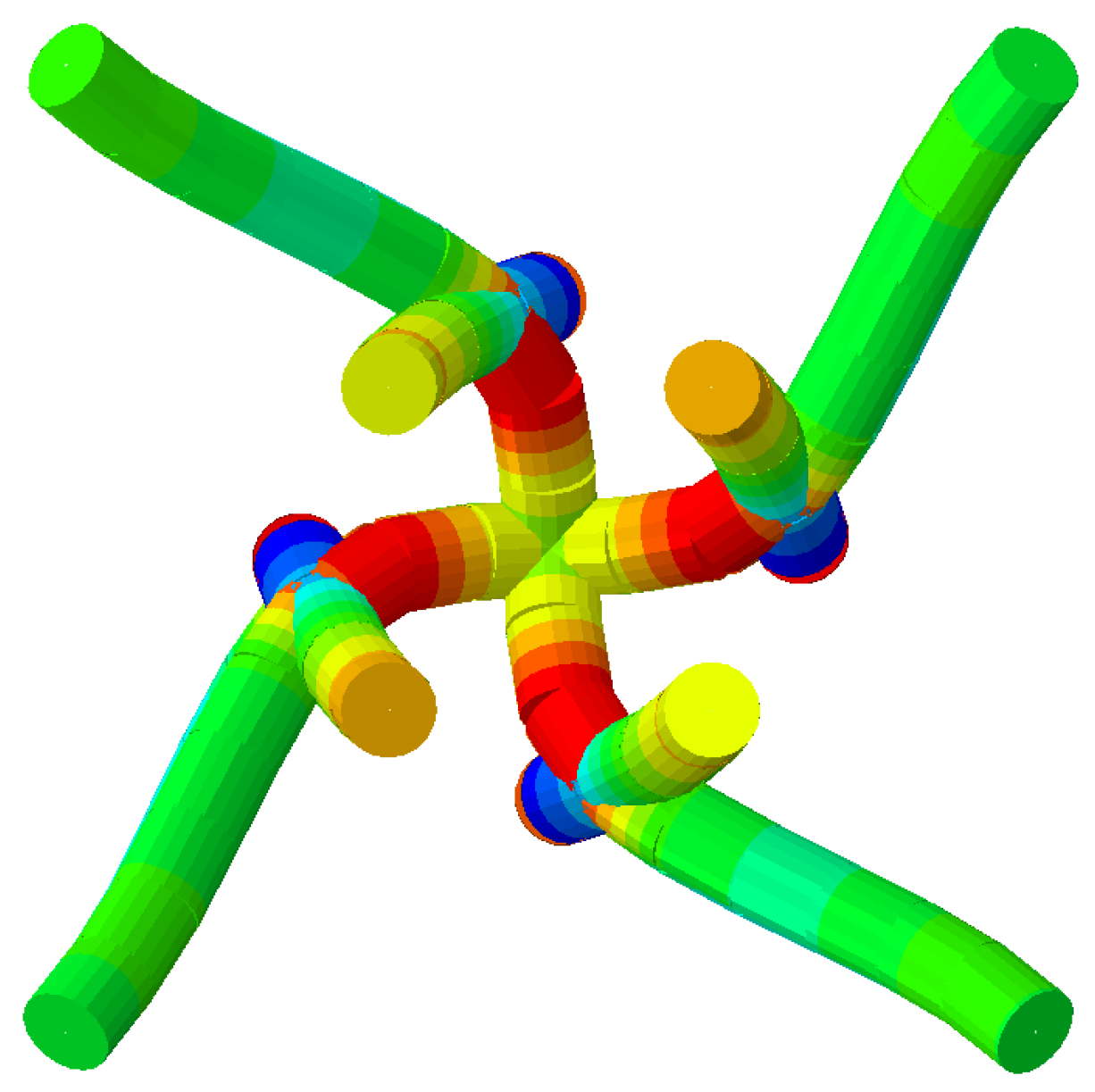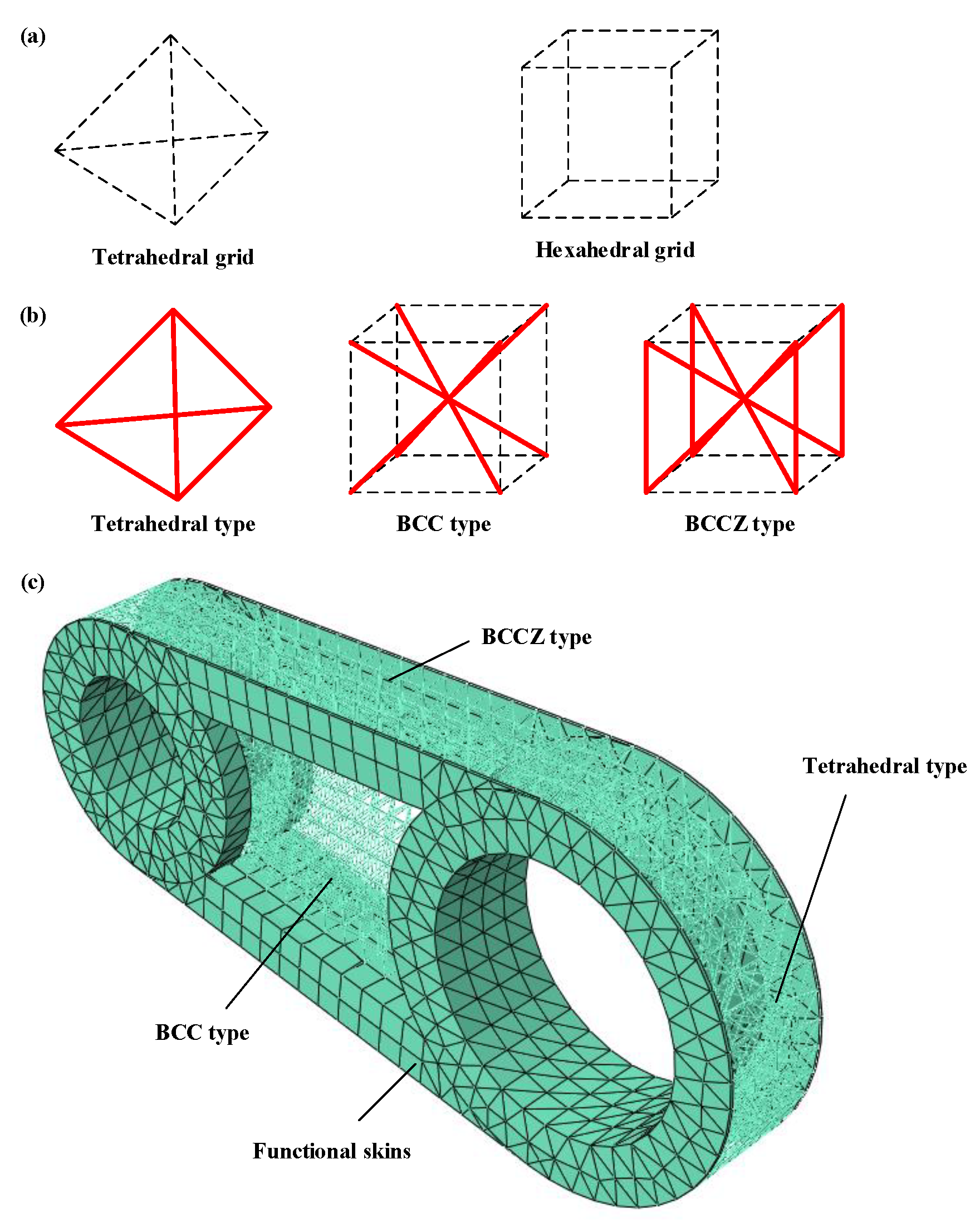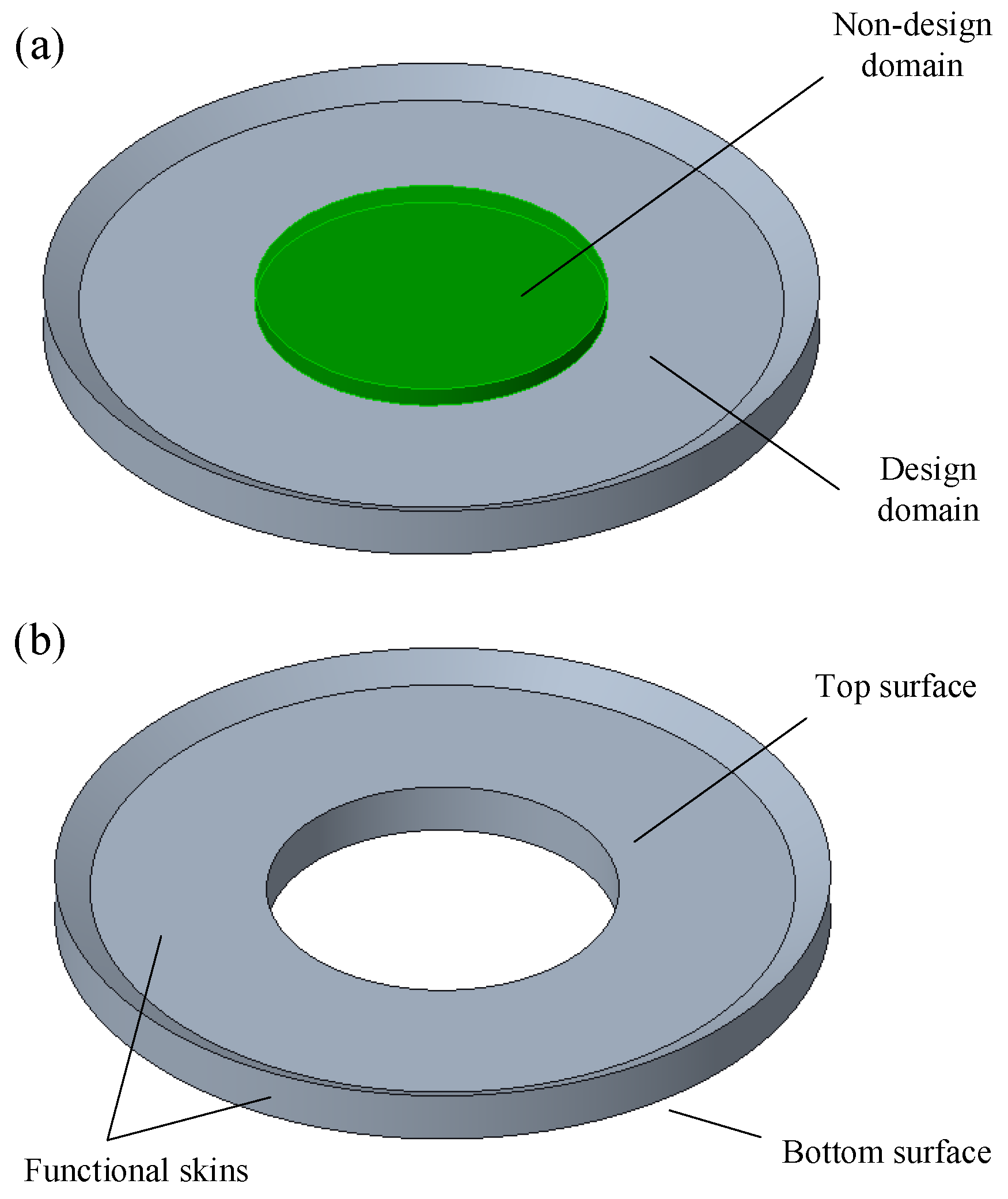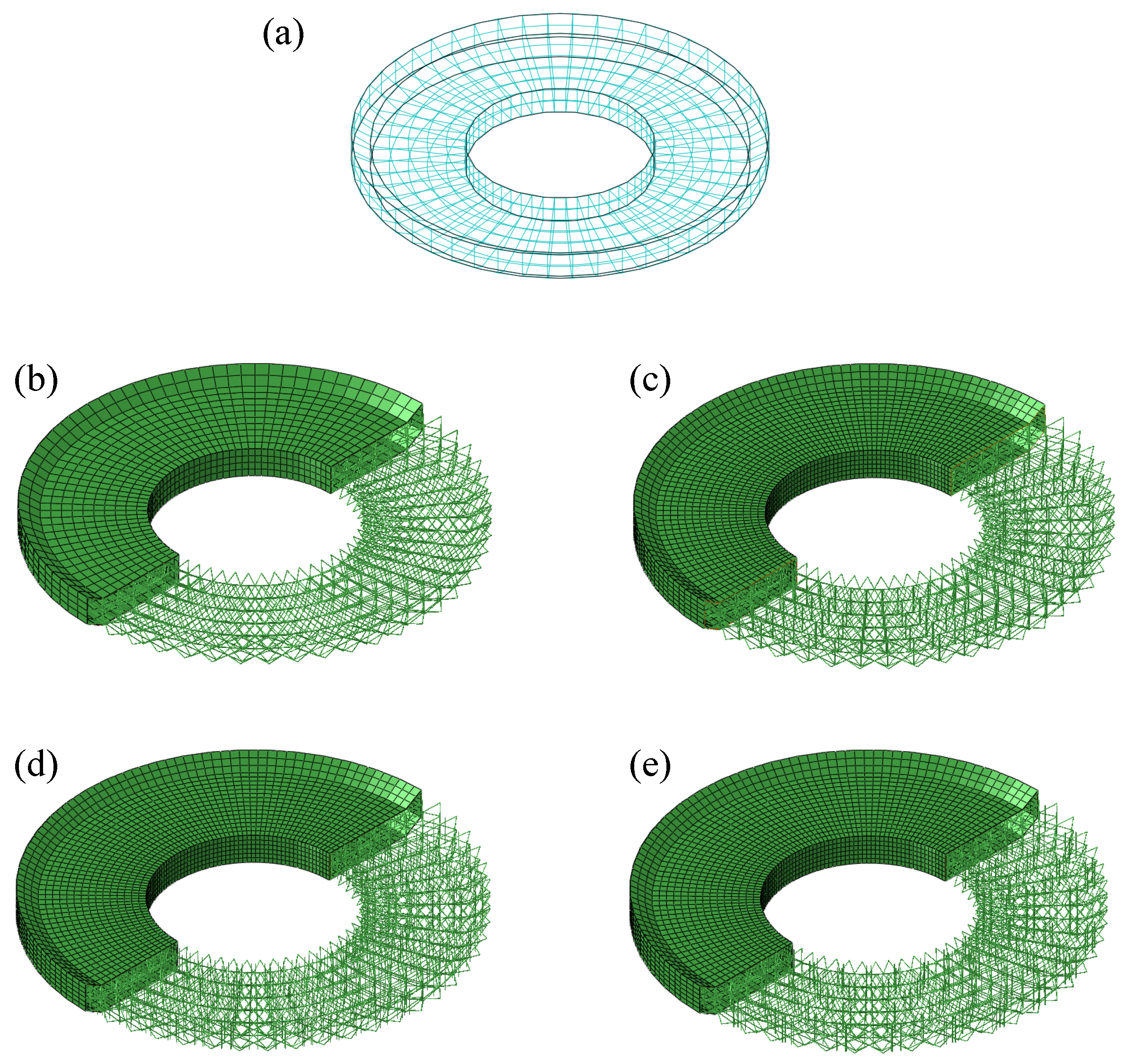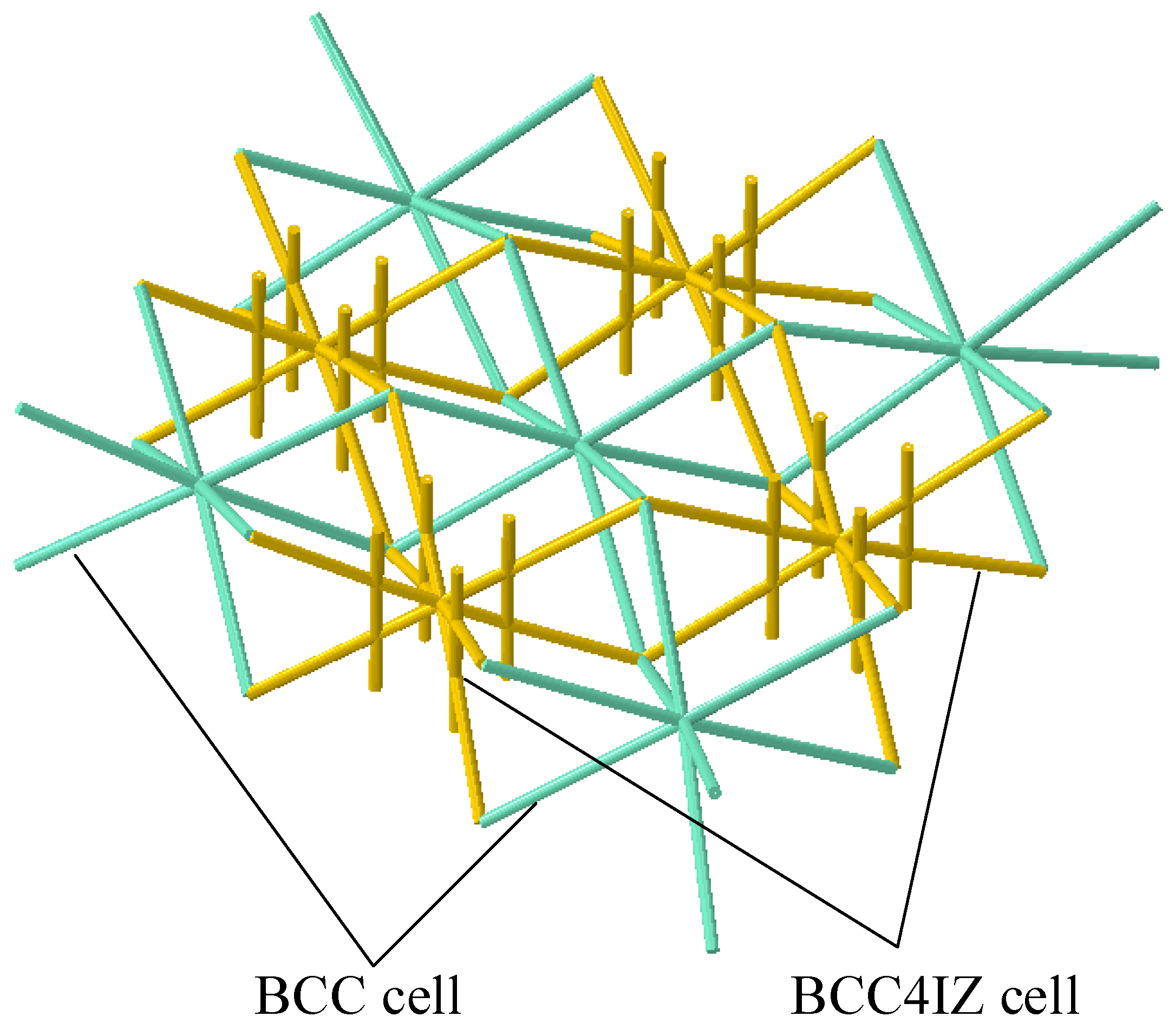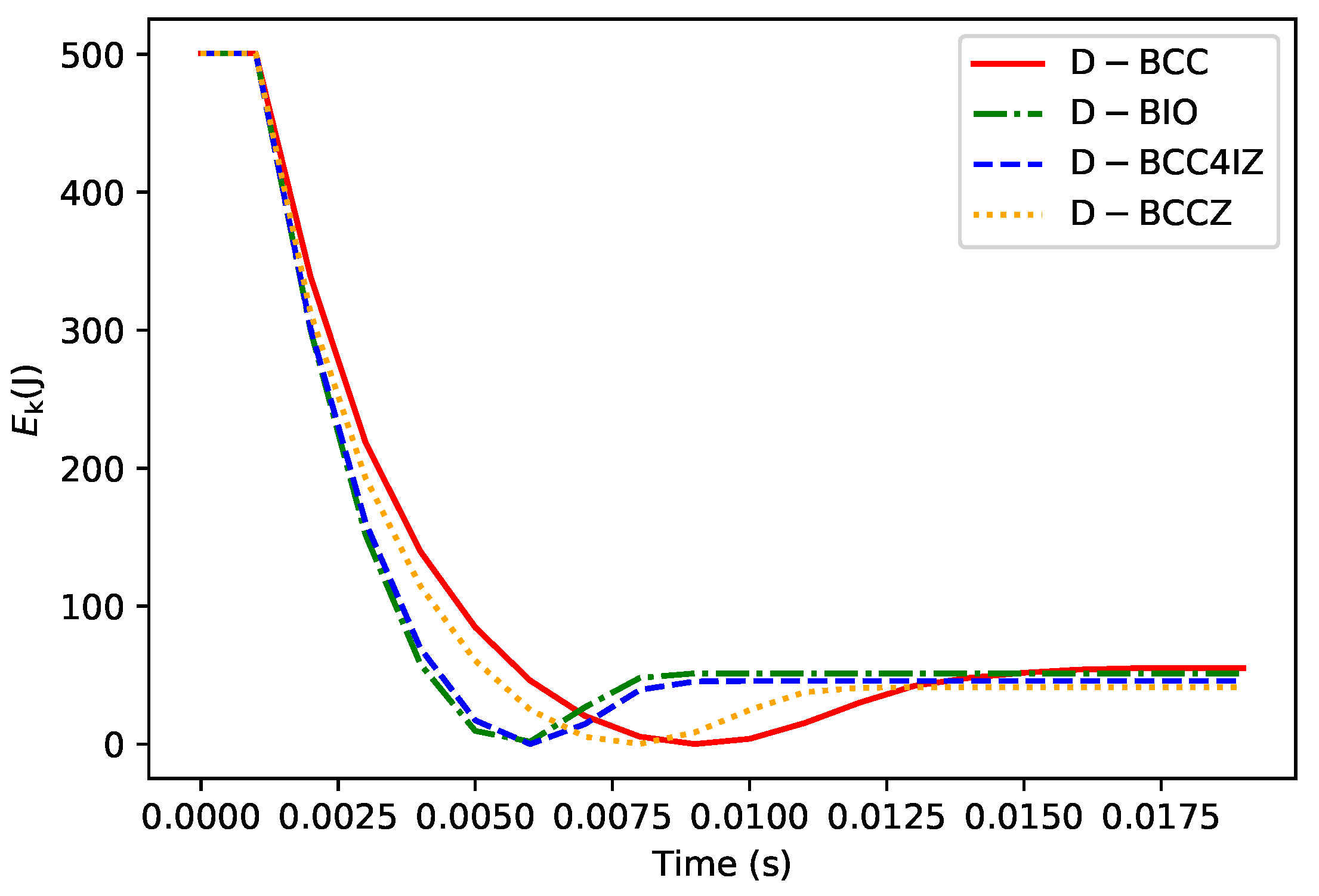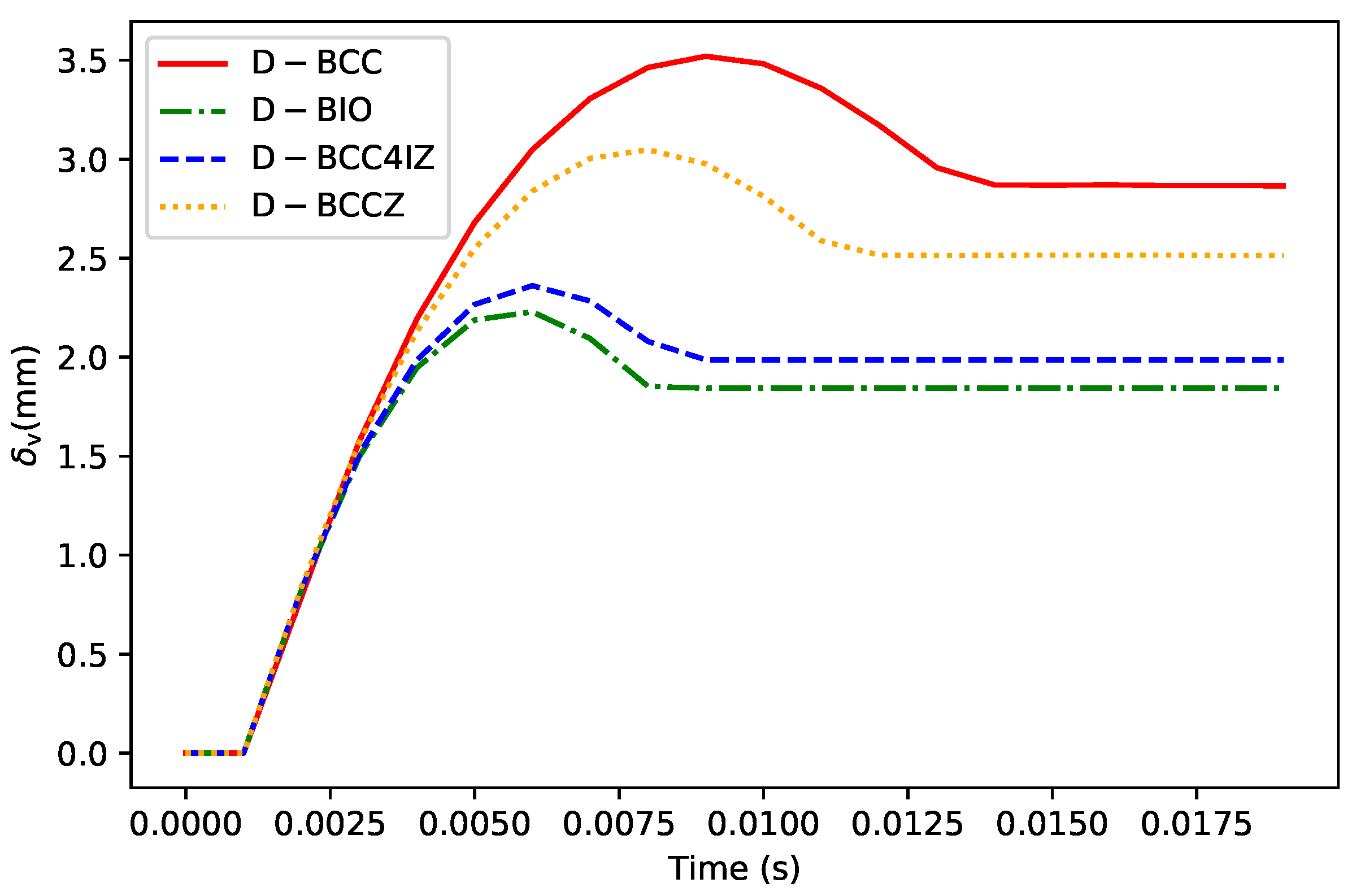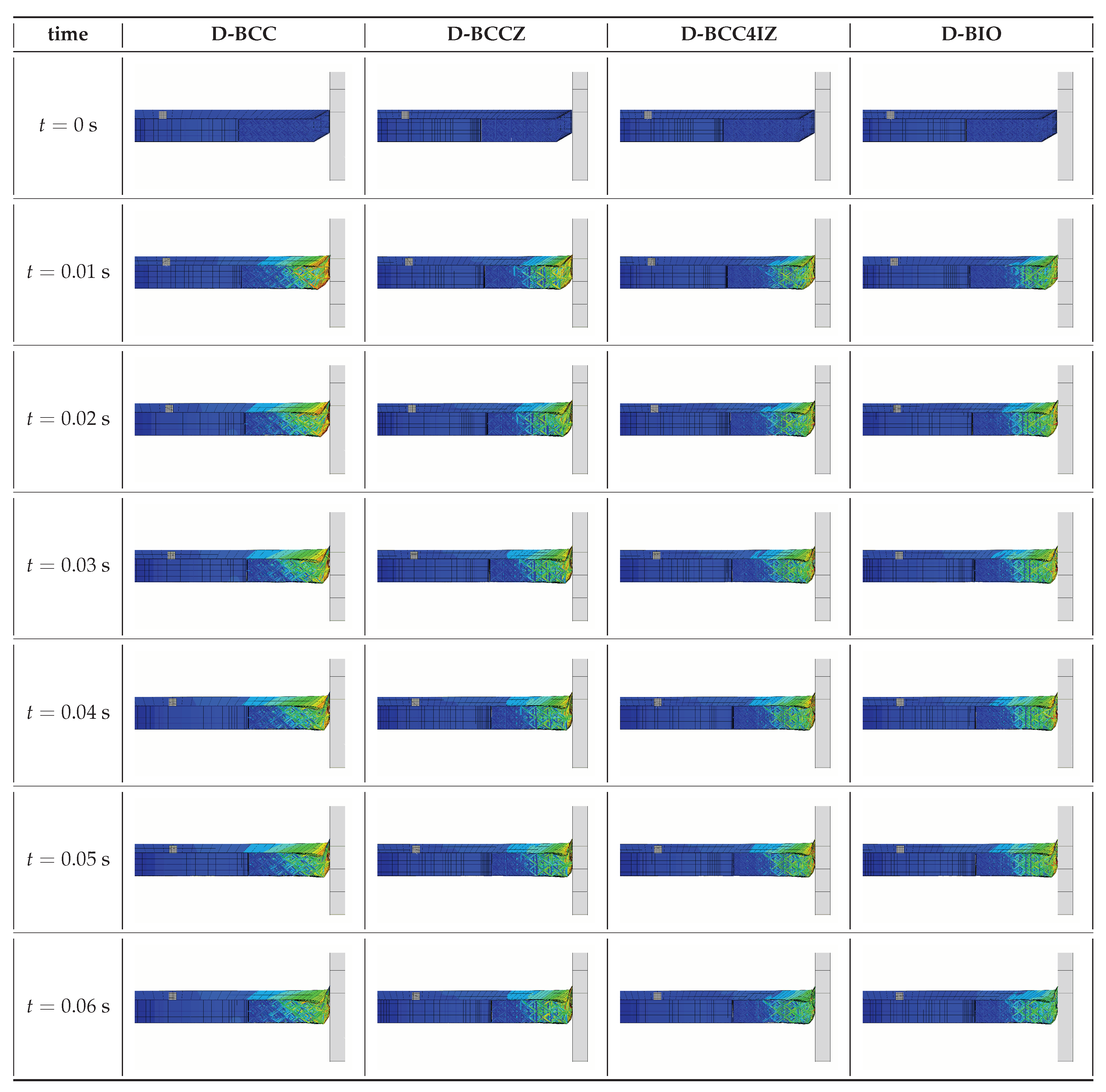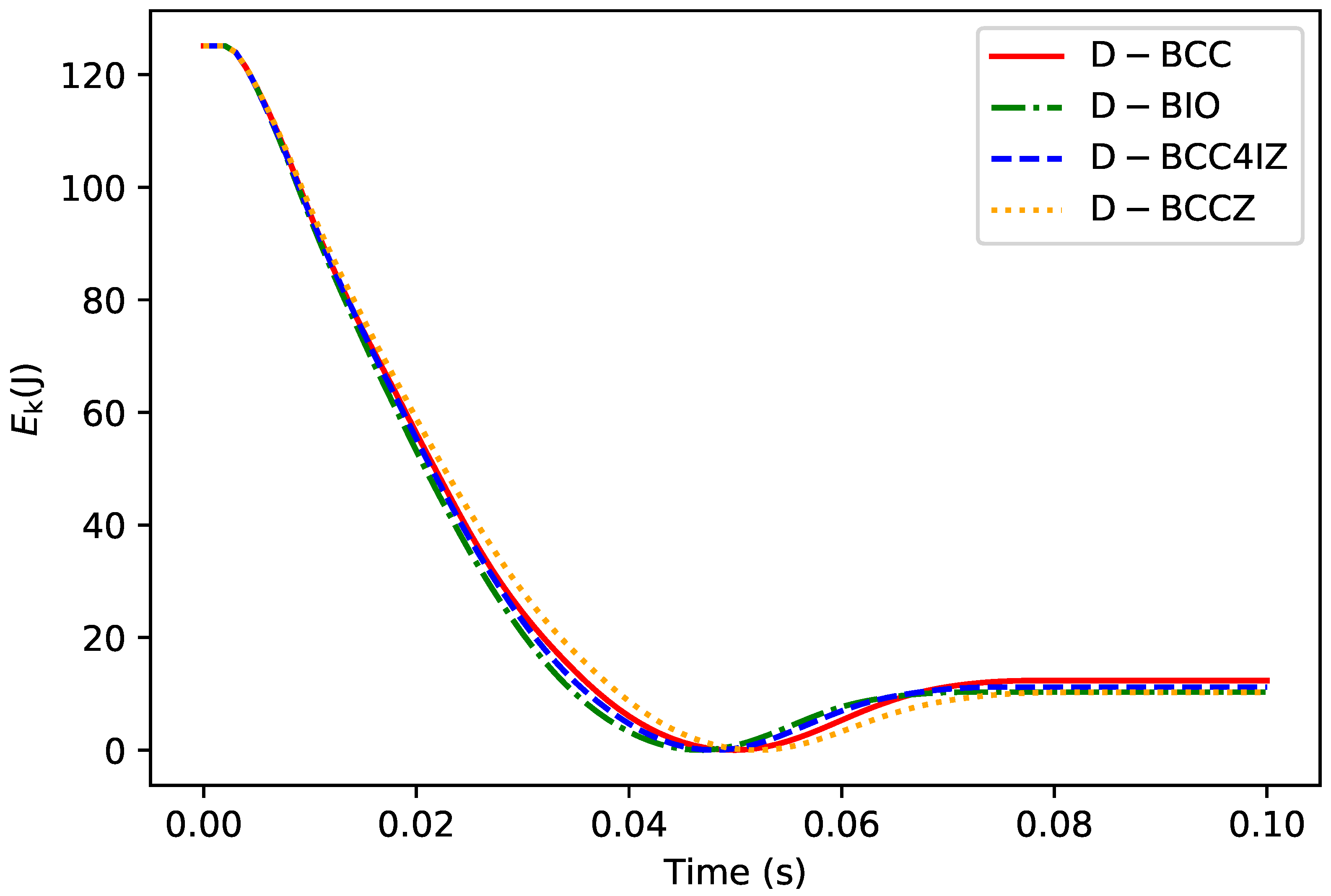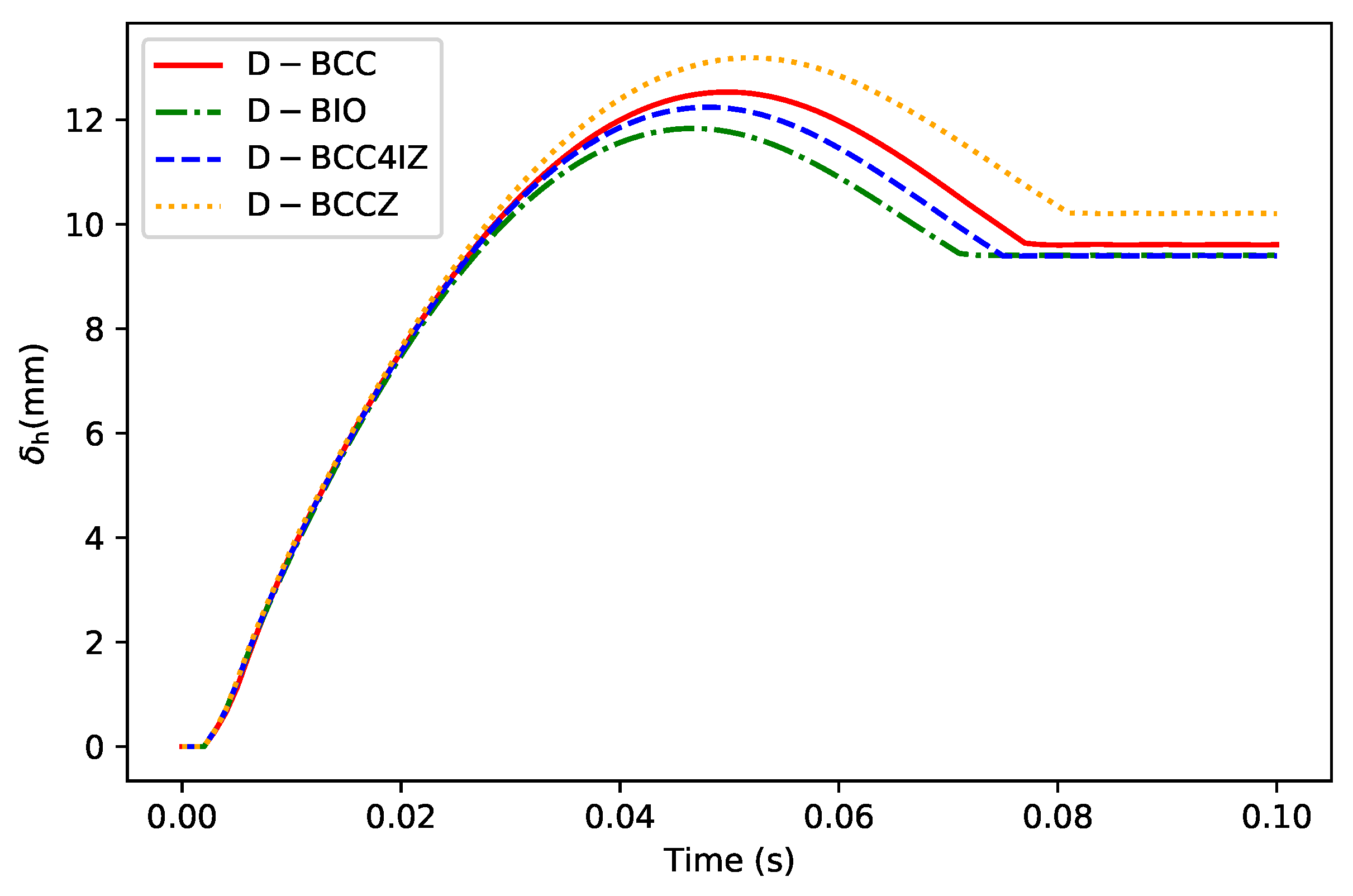1. Introduction
Because of their excellent mechanical properties and multifunctionality, lattice structures have received widespread attention in both academia and industry. The lattice structures have a variety of topological configurations, and each unit can be defined by different parameters, thus demonstrating a higher designability than the conventional metal foams [
1].
Since the concept of lattice structure was put forward, its mechanical properties, especially the energy absorption, have been widely studied. Typical lattice cell configurations such as BCC (DIAG) [
2,
3,
4,
5,
6,
7], OCTET [
8,
9,
10], and SC [
7,
11,
12,
13,
14], have received a lot of research including analysis, modeling, and experimental methods. Compared with 1D and 2D [
15,
16,
17], a 3D periodic lattice structure can exhibit anisotropic macro characteristics to meet more complex design requirements—however, also making its design more complex [
18,
19]. Deshpande et al. [
8] analyzed the mechanical properties of octet lattice cell structure and established a mechanical model for the octet lattice cell. Ushijima et al. [
20] developed a prediction model to analyze the stiffness and strength of the bending dominated BCC cell lattice structure. However, predictive models are usually only available for lattice structures composed of periodic unit cells. For varying lattice configurations and non-uniform lattice structures, the finite element analysis method is a common alternative. Many studies employ solid elements to discrete the lattice structure. While solid elements are versatile for structural analysis, they often result in large-scale finite element models for lattice structures. In order to improve the efficiency of the finite element analysis, scholars also studied the simplified or equivalent modeling approaches. Smith et al. [
21] employed the beam elements to model the rods in the lattice cells and improved the accuracy by increasing the diameter of the beam elements at the joint of the cells. Liu et al. [
5] established a theoretical model and a finite element model of the multilayer BCC lattice structure and compared the theoretical and finite element analysis results with the experimental results.
Compared with standard and uniform lattice structures, studies on lattice cell structures with non-uniform configurations are relatively few. However, the microstructures in polycrystal and animal bones are generally non-uniform and they also provide a rich reference for the design of lattice cells. Pham et al. [
22] studied microstructure of polycrystalline metals and introduced grain boundary hardening, precipitate strengthening, and multiphase strengthening into the design of the lattice structure. The results show that the lattice structure with the above strengthening method exhibits a mechanical behavior similar to that of alloy crystals, thereby strengthening the overall performance of the lattice structure. Bian and Li et al. [
23,
24,
25] designed a series of polycrystal-inspired lattice structures by studying the structural form of polycrystals and. Yang et al. [
26] proposed a lattice cell configuration by topology optimization method. The design result is very similar to the structure of cuttlebone and shows excellent compression-resistant and energy absorption capability. Fernandes et al. [
27] and Sharma et al. [
28] studied the lattice structure for energy absorption with eupletella aspergillum as the bionic object, The design results demonstrate excellent performance in terms of both the structural robustness and energy absorption.
Besides, the microstructure of bamboo and its spatial distribution has also been taken as bionic design references [
29,
30,
31,
32]. Ray et al. [
33] stated that bamboo is one of the best functionally gradient composite materials available and studied the correlation between vascular bundle microstructure and mechanical strength. Sato et al. [
34] determined the optimal stiffness design for fiber-reinforced cylindrical composites, which is very similar to the wild bamboos. Fu et al. [
35] proposed a bionic-bamboo tube (BBT) structure, which is inspired by both the structural form of vascular bundle and the simple circumferential distribution law. The results show that the energy absorption capacity of BBT structure is significantly higher than that of the initial design. Xu et al. [
36] employ the vascular bundle microstructure of bamboo as the design reference to improve the crashworthiness design of bumper.
The landing footpad is a critical component of the lunar lander, whose performance is crucial to a successful landing. Its main function is to resist impact deformation while absorbing impact energy. In this study, the design goal is to improve the footpad’s ability to resist impact deformation while preserving its capability of energy absorption. Bamboo, characterized by its vascular bundle structure, inspires this bionic design. A novel lattice cell configuration, namely the BCC4IZ, is proposed, based on which one bionic design for landing footpads is developed. Then, the layout of the vascular bundle structure in the bamboo cross-section is also taken as the bionic design object. Combined with the proposed lattice cell configuration, another bionic design for the landing footpad is also developed. The above two biomimetic designs are compared with the traditional lattice cell configuration. The results demonstrated that the bionic designs can increase the capacity of the footpad for resisting impact deformation without reducing the energy-absorbing performance, which also verify the rationality of the biomimetic design method.
The layout of this paper is organized as follows:
Section 2 introduces the bamboo-inspired bionic lattice cell configuration and lattice alternative layout.
Section 3 describes the design and modeling method of lattice cell configuration and lattice structure.
Section 4 introduces the design object and models employed in this work.
Section 5 discusses the results with numerical examples to illustrate the advantages of bionic designs. Finally, the conclusions are summarized in
Section 6.
5. Results and Discussion
In this paper, ABAQUS software is used for FEA modeling and analysis. The material parameters used in the model are shown in
Table 3.
Rods in four designs are discretized into 3–6 elements according to the size of lattice, so as to ensure that the element size between the different models are approximately the same as . The total time and interval of the analysis are set to 0.05 s and 0.001 s, respectively. The calculation time for each simulation is about 2 h.
5.1. Condition 1: Vertical Cushioning
The landing cushioning process of the four designs are shown in
Figure 15.
The results show that in the vertical landing condition, the cushioning process of different designs is generally similar and lasted about 0.01 s. After 0.012 s, each design begins to move vertically upwards. Meanwhile, the structure rebounded and the deformation decreased. In this paper, the kinetic energy changes before and after cushioning are concerned to evaluate the energy absorption performance of the different designs. The kinetic energy
curves of the four designs are shown in
Figure 16.
As listed in
Table 4, the initial kinetic energy of the four designs are the same due to the fact that all the designs have the same total mass and the same initial velocity. The final D-BCC kinetic energy is slightly higher than other designs, and the final kinetic energy of the other designs are similar.
On the other hand, we further consider the deformation of the footpad during the cushioning process. The changing distance between the two points at top and bottom surfaces of the structure is used to measure the deformation in the vertical direction as
. The time histories of
for the four designs are shown in
Figure 17 and the maximum and end values of them are listed in
Table 5.
According to the results, the bionic design of D-BCC4IZ and D-BIO has better capacity against impact deformation than D-BCC and D-BCCZ. In terms of the value of , D-BCC4IZ is and lower than D-BCC and D-BCCZ, respectively; meanwhile, those of D-BIO are and lower than D-BCC and D-BCCZ, respectively. According to the parameters, the values of total mass for Z rods in D-BCCZ, D-BCC4IZ, and D-BIO are the same; however, D-BIO adopts a different layout of lattice, so that the mass is distributed more reasonably.
5.2. Condition 2: Horizontal Cushioning
The landing cushioning process of the four designs is shown in
Figure 18.
Similar to
Section 4.1, the changing distance between the two points of the structure to measure the deformation in the horizontal direction as
and the time histories of
for the four designs are shown as
Figure 20 and the maximum and end values of them are listed in
Table 7.
The four designs show no significant difference in energy absorption. However, unlike that in
Section 4.1, the deformation of D-BCCZ in the horizontal direction exceeds that of D-BCC. This is because the Z rods of D-BCCZ cannot increase the rigidity of the structure in the horizontal direction, but instead separate the mass of the normal rods. On the other hand, although not as obvious in the vertical direction, the capacity of resisting impact deformation of D-BCC4IZ and D-BIO in the horizontal direction is also better than that of D-BCC and D-BCCZ.
6. Conclusions
To improve the cushioning performance of the landing footpad, this study proposes a bionic design method of the non-uniform lattice structure. Firstly, based on the vascular of bamboo structure, a lattice cell configuration BCC4IZ and a bionic layout are proposed. In order to establish the model of lattice structure using the above design, this paper proposes a lattice cell configuration design and modeling method. Then, four footpad designs with different lattice configurations and layouts are presented and analyzed under vertical and horizontal cushioning conditions. Finally, the results of and are compared to evaluate the performance of the different designs. The conclusions are summarized as follows.
(1) The design and modeling methods proposed in this paper successfully parameterized the configuration and layout of the bionic design. Both bionic configuration and layout are also correctly applied to the design of the footpad, which proves the effectiveness of the design and modeling methods;
(2) For vertical cushioning, the numerical values of and indicate that the BCC4IZ cell is similar to BCC and BCCZ in terms of energy absorption while it is superior to them in terms of the vertical capacity of resisting impact deformation. During the cushioning process, of D-BCC4IZ decreased by and compared with that of D-BCC and D-BCCZ, respectively. It shows that the BCC4IZ cell configuration can effectively improve the impact deformation resistance of the structure in the vertical direction;
(3) For horizontal cushioning, there is no significant difference in the energy absorption performance of the D-BCC, D-BCCZ, and D-BCC4IZ. However, compared with D-BCC, D-BCCZ has a higher in the horizontal direction. This is because the presence of the Z rods in D-BCCZ divides part of the mass from normal rods under the constraint of the given total mass, resulting in the reduction of the horizontal capacity of resisting impact deformation. However, the D-BCC4IZ cell configuration with Z rods has the same overall mass as D-BCCZ, but its is lower than D-BCC and D-BCCZ. The reason for the above results is that most of the Z rods in BCCZ do not participate in the horizontal impact process, but the Z rods and normal rods in BCC4IZ form a stable shape and cut the normal rods into smaller ones, which indirectly reduces the in the horizontal direction. The results of the two cases show that the cell configuration of BCC4IZ outperforms BCC and BCCZ in the overall impact deformation resistance;
(4) Furthermore, this paper obtained the fourth design D-BIO of the footpad by combining BCC4IZ and bamboo-inspired alternative layout. Due to the reduced number of BCC4IZ in D-BIO, the overall length of the z rods decreased, but the mass is distributed more equitably. Compared with that of D-BCC, D-BCCZ, and D-BCC4IZ, the maximum deformation of D-BIO in the vertical direction is reduced by , , and , respectively. Horizontally, the D-BIO also slightly outperforms the D-BCC4IZ. It further proves the validity of the design method combining bionic design and lattice structure.
